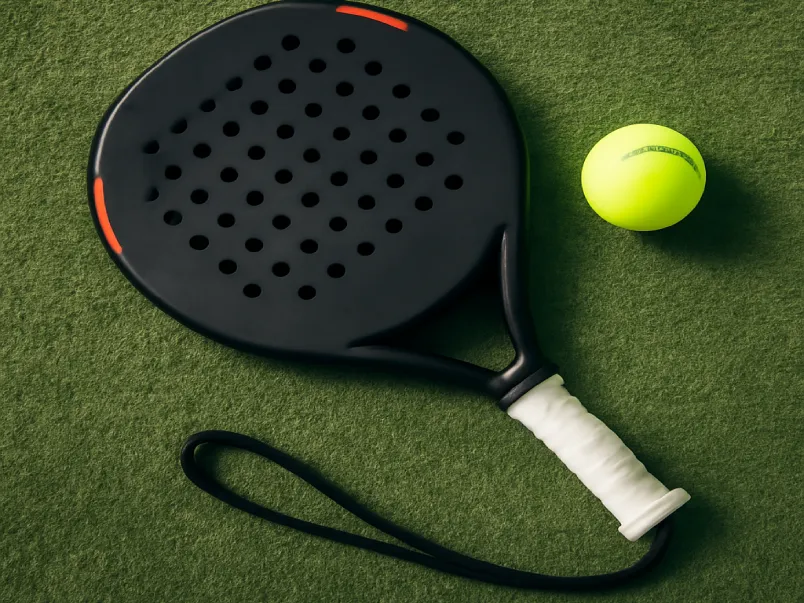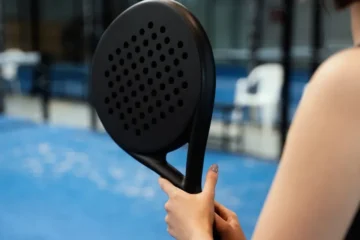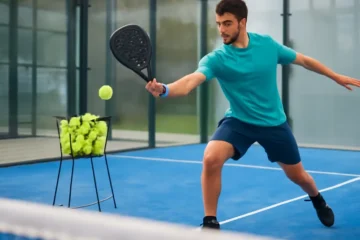Why Weight is a Game-Changer
Imagine stepping onto the court, racket in hand, ready for an intense game of padel. You take your first swing and feel the weight of your racket — but does it feel right? The difference between a sluggish, hard-to-control racket and one that feels like an extension of your arm can be the deciding factor in your performance. Padel, like other racquet sports, requires precision, agility, and control, and the weight of your racket plays a crucial role in all these factors.
The weight of your padel racket is more than just a number on the scale. It directly affects your ability to generate power, maintain control, and move with agility around the court. Understanding how the weight impacts these factors will help you make an informed decision when choosing your perfect racket. In this guide, we will break down everything you need to know about padel racket weight, including the different weight classes, how to choose the right weight for your playing style, and why balance is just as important as weight itself.
1. Understanding Padel Racket Weight Classes
When it comes to padel rackets, weight is classified into three main categories: lightweight, medium weight, and heavyweight. Each of these categories has distinct characteristics that cater to different player needs and playing styles. Let’s take a closer look at the different weight ranges and what they offer.
Lightweight (355g – 365g): The “Maneuverability” Class
Lightweight rackets are ideal for players who value agility and quick reactions. Weighing between 355g and 365g, these rackets allow for fast swings, making them perfect for net play, quick volleys, and rapid responses to your opponent’s shots. If you’re a beginner or a recreational player, a lightweight racket might be your best choice as it will help you develop your reflexes and consistency without causing undue fatigue.
Medium Weight (365g – 375g): The “All-Round” Class
Medium-weight rackets, falling between 365g and 375g, strike a balance between power and control. These rackets are versatile and cater to intermediate players who have developed a stable technique and are looking to improve their overall game. If you want a racket that can handle a variety of playstyles — from baseline rallies to net play — a medium-weight racket offers the flexibility needed to elevate your game.
Heavyweight (375g – 385g+): The “Power” Class
Heavyweight rackets are designed for advanced players who prioritize power. These rackets typically weigh between 375g and 385g or more, and their mass provides excellent stability during hard shots and volleys. The added weight helps generate more power behind each swing, making them ideal for players with a strong physique and advanced technique. However, heavier rackets can feel sluggish and may require more strength and endurance to wield effectively.
Pro Tip: Weight vs. Balance
While weight plays a significant role in how a racket performs, balance is just as important. A racket’s balance (head-heavy, even, or head-light) can make two rackets of the same weight feel completely different. In the next section, we’ll dive deeper into the relationship between weight and balance and how it affects your game.
2. The Core Trade-Off: Power vs. Control & Maneuverability
Choosing the right racket weight is about finding a balance between power, control, and maneuverability. The weight of your racket will influence these factors, but the trade-off is clear: heavier rackets offer more power, while lighter rackets allow for quicker reactions and better control.
Heavier Rackets
Pros:
- Power: A heavier racket has more mass behind each swing, which translates to more power when hitting the ball. This is ideal for baseline players who want to generate more speed and force on their shots.
- Stability: Heavy rackets are more stable on volleys and against hard shots, which makes them a great choice for players who engage in long rallies or powerful exchanges at the net.
Cons:
- Slower Reactions: Heavier rackets can be slower to swing, especially when making quick movements at the net. This may limit your ability to respond to fast balls or execute finesse shots like bandejas and viboras.
- Physical Demands: Using a heavier racket requires more physical strength and endurance. Over time, this can lead to fatigue and increase the risk of injury, particularly in the elbow and shoulder areas.
Lighter Rackets
Pros:
- Speed and Agility: Lighter rackets are easier to swing quickly, which is especially important for players who want to react fast to their opponent’s shots. They allow for better maneuverability, which is crucial for net play and fast-paced exchanges.
- Less Physical Strain: Lighter rackets are easier on the arm and shoulder, making them a good choice for players who are recovering from injury or who prefer to focus on control rather than power.
Cons:
- Less Power: While lighter rackets offer more maneuverability, they don’t have the same power generation as heavier rackets. This can be a disadvantage for players who rely on heavy smashes and powerful groundstrokes.
- Less Stability: Lighter rackets can feel unstable, especially on off-center hits, leading to more vibration. This can impact comfort and overall performance, particularly for players who rely on consistency.
3. Choosing Your Weight: A Player Profile Guide
Choosing the right racket weight is not a one-size-fits-all decision. Your level of play, playing style, and physical condition will influence the weight of the racket that best suits you. Here’s a simple guide to help you choose based on your profile.
The Beginner / Recreational Player
Recommended Weight: Lightweight to Medium (355g – 370g)
Reasoning: As a beginner, your focus should be on developing technique and consistency. A lighter racket will help you get to the ball more easily and reduce fatigue, allowing you to focus on your form without feeling overwhelmed by the racket’s weight. A lightweight racket is also more forgiving on off-center hits, which is a common issue for new players.
The Intermediate / Control-Oriented Player
Recommended Weight: Medium (365g – 375g)
Reasoning: Intermediate players have typically developed a solid foundation and are now looking to refine their technique. A medium-weight racket offers the best balance between power and control, allowing for better placement, spin, and precision. This weight is also well-suited for players who want to improve their net play and develop sharper angles.
The Advanced / Power Player
Recommended Weight: Medium to Heavyweight (370g – 385g)
Reasoning: Advanced players, especially those who generate their own power, often prefer a medium or heavyweight racket. The extra mass behind the ball provides greater stability and power on groundstrokes, smashes, and volleys. Players with strong physical conditioning and advanced technique can handle the additional weight for a full match without experiencing excessive fatigue.
The Player with Arm Problems (Tennis Elbow)
Recommended Weight: Lightweight (355g – 365g)
Reasoning: Players dealing with arm issues, such as tennis elbow, should opt for a lightweight racket. Lighter rackets place less strain on the tendons and muscles, reducing the risk of further injury. In addition, a racket with a soft core (e.g., EVA Foam) and a round shape can help absorb shock and increase comfort during play.
4. Beyond the Scale: The Crucial Role of Balance
While weight is essential, the balance of your racket plays an equally significant role in how it feels during play. Two rackets with the same weight can feel completely different depending on their balance.
Head-Heavy Balance
A head-heavy racket feels heavier in the head (the part with the strings), which generates more power from the baseline and during overhead smashes. This type of balance is ideal for players who want to dominate with powerful shots but may sacrifice maneuverability at the net.
Even Balance
An even-balanced racket offers a perfect compromise between power and control. It’s ideal for players who want a versatile racket that can perform well in all aspects of the game. If you like to play both at the baseline and the net, an even balance may be your best option.
Head-Light Balance
Head-light rackets feel lighter and faster, especially when you’re swinging at the net or reacting to quick shots. This balance is favored by players who prioritize control, reaction volleys, and finesse shots. Head-light rackets allow for more wrist action and give the feeling of an extension of your hand.
5. Your Step-by-Step Selection Process
Now that you understand the key factors affecting your racket choice, here’s a simple step-by-step process to help you select the right racket.
- Assess Your Level & Style: Refer to the Player Profile Guide above and determine where you fall. Are you a beginner, intermediate, or advanced player? Do you prioritize power, control, or agility?
- Consider Physical Strength & Fitness: Be honest about your physical strength and endurance. If you’re new to the sport or have arm problems, a lightweight racket may be more suitable. Stronger players may benefit from the additional power offered by a heavier racket.
- Try Before You Buy (If Possible): The best way to determine if a racket feels right is to try it out. Mimic your shots (volleys, smashes, etc.) and see how the racket performs. Pay attention to how it feels during different strokes and how comfortable it is during play.
- Feel the “Swing Weight”: Don’t just go by the weight on the scale. The swing weight refers to how heavy the racket feels when you swing it. A racket with a higher swing weight will feel more cumbersome, while a racket with a lighter swing weight will be quicker to maneuver.
- Read Reviews & Specs: Check customer reviews and product specifications. Look for feedback on maneuverability, comfort, and performance. This will give you a better idea of what to expect.
Conclusion: Your Perfect Match Awaits
Choosing the right racket weight is a personal journey that depends on your unique playing style, physical capabilities, and preferences. There’s no single “best” weight for everyone, but by understanding the impact of weight and balance, you can find the racket that enhances your game and helps you play at your best. Remember, the perfect racket is the one that feels comfortable, boosts your confidence, and, most importantly, allows you to enjoy the game of padel to the fullest.
Use this guide as a starting point, and don’t be afraid to experiment with different weights and balances until you find the one that feels just right. Happy playing!
FAQs:
1. What is the ideal weight for a padel racket?
The ideal weight of a padel racket depends on your playing style and experience. Beginners often prefer lighter rackets (355g – 365g) for maneuverability, while intermediate players may opt for medium-weight rackets (365g – 375g) for a balance of power and control. Advanced players typically prefer heavier rackets (375g – 385g+) for added power.
2. How does the weight of a padel racket affect my game?
The weight of a racket influences power, control, and maneuverability. Heavier rackets provide more stability and power, making them suitable for baseline players. Lighter rackets allow for faster reactions and better control, which is ideal for net play and precise shots.
3. Can a lighter racket prevent arm injuries?
Yes, lighter rackets reduce strain on the arm, making them a good option for players with arm issues, such as tennis elbow. Additionally, rackets with a soft core, like EVA foam, can further reduce shock and vibration, enhancing comfort and injury prevention.
4. What does “balance” mean in a padel racket?
Balance refers to how the weight is distributed along the racket. Head-heavy rackets provide more power and stability, ideal for smashes, while head-light rackets offer faster swings and better control, making them perfect for net play. An even balance provides a mix of both.
5. How do I know if a padel racket is too heavy for me?
If you feel fatigued quickly or have difficulty controlling the racket during play, it may be too heavy for you. A racket that feels sluggish or strains your arm may not be the right fit, especially if you’re just starting out or have less strength.
6. Can I switch between different racket weights?
Yes, players often experiment with different racket weights as they progress in their skills or adjust their playing style. Starting with a lighter racket and gradually increasing weight as your strength and technique improve is a common approach.




